Abstract
In the most recent years, the Semantic Web has become a most promising research field, which tries to automate and support sharing and reuse of the data and metadata representing the growing amount of digital information available to our society. The underlying idea of having a description of the data on the Web, in such a way that it can be employed by machines for automation, integration and reuse across various applications, has been exploited in several research fields. However, the gigantic amount of such useful information makes more and more difficult its efficient management, undermining the possibility to transform it into useful knowledge.
Preview
Unable to display preview. Download preview PDF.
Similar content being viewed by others
Author information
Authors and Affiliations
Corresponding author
Editor information
Editors and Affiliations
Rights and permissions
Copyright information
© 2010 Springer-Verlag Berlin Heidelberg
About this chapter
Cite this chapter
De Virgilio, R., Giunchiglia, F., Tanca, L. (2010). Introduction. In: de Virgilio, R., Giunchiglia, F., Tanca, L. (eds) Semantic Web Information Management. Springer, Berlin, Heidelberg. https://doi.org/10.1007/978-3-642-04329-1_1
Download citation
DOI: https://doi.org/10.1007/978-3-642-04329-1_1
Published:
Publisher Name: Springer, Berlin, Heidelberg
Print ISBN: 978-3-642-04328-4
Online ISBN: 978-3-642-04329-1
eBook Packages: Computer ScienceComputer Science (R0)




